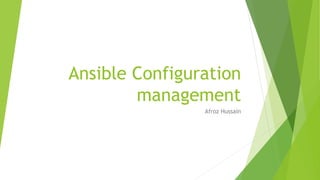Recommended
Ansible Automation - Enterprise Use Cases | Juncheng Anthony LinAnsible Automation - Enterprise Use Cases | Juncheng Anthony Lin

Ansible Automation - Enterprise Use Cases | Juncheng Anthony LinVietnam Open Infrastructure User Group
More Related Content
What's hot
Ansible Automation - Enterprise Use Cases | Juncheng Anthony LinAnsible Automation - Enterprise Use Cases | Juncheng Anthony Lin

Ansible Automation - Enterprise Use Cases | Juncheng Anthony LinVietnam Open Infrastructure User Group
What's hot (20)
Ansible Tutorial For Beginners | What Is Ansible And How It Works? | Ansible ...

Ansible Tutorial For Beginners | What Is Ansible And How It Works? | Ansible ...
What Is Ansible? | How Ansible Works? | Ansible Tutorial For Beginners | DevO...

What Is Ansible? | How Ansible Works? | Ansible Tutorial For Beginners | DevO...
Ansible Automation - Enterprise Use Cases | Juncheng Anthony Lin

Ansible Automation - Enterprise Use Cases | Juncheng Anthony Lin
Similar to Ansible
Similar to Ansible (20)
Hands On Introduction To Ansible Configuration Management With Ansible Comple...

Hands On Introduction To Ansible Configuration Management With Ansible Comple...
Top 50 Ansible Interview Questions And Answers in 2023.pdf

Top 50 Ansible Interview Questions And Answers in 2023.pdf
Ansible Automation Best Practices From Startups to Enterprises - Minnebar 12

Ansible Automation Best Practices From Startups to Enterprises - Minnebar 12
Introduction to Ansible - (dev ops for people who hate devops)

Introduction to Ansible - (dev ops for people who hate devops)
Ansible 2.0 - How to use Ansible to automate your applications in AWS.

Ansible 2.0 - How to use Ansible to automate your applications in AWS.
Ansible 2.0 - How to use Ansible to automate your applications in AWS.

Ansible 2.0 - How to use Ansible to automate your applications in AWS.
Ansible
- 2. Agenda What is Ansible? How is it different? how does it work? Installation The ansible tools Running some adhoc commands What is Playbooks? Basic playbook Handlers Roles Demo: Playbook for Apache
- 3. What is Ansible? Ansible is a radically simple IT automation engine that automates cloud provisioning, configuration management, application deployment, intra- service orchestration Ansible’s goals are foremost those of simplicity and maximum ease of use. Ansible manages machines in an agentless manner. There is never a question of how to upgrade remote daemons or the problem of not being able to manage systems because daemons are uninstalled. It uses a very simple language (YAML, in the form of Ansible Playbooks) that allow you to describe your automation jobs in a way that approaches plain English.
- 4. How is it different? Agent-less architecture Configuration as data, not code Betterires-included(module). Full configuration management, orechestration, deployment.
- 5. How does it work?
- 6. Installation Installation RHEL/CentOS/Fedora 1. Enable EPL on RedHat ## RHEL/CentOS 6 64-Bit ## # rpm -ivh http://download.fedoraproject.org/pub/epel/6/x86_64/epel-release-6-8.noarch.rpm # yum repolist # verify the EPL Repo 2. Install ansible #yum install ansible -y # ansible --version # verify the ansible installation 3. Preparing ssh keys to connect to remote hosts # ssh-keygen -t rsa -b 4096 4. Agent setup cat /root/.ssh/id_rsa.pub >> /root/.ssh/authorized_keys Note : Please make sure .ssh has 700 and authorized_keys has 400 permission
- 7. Ansible comes with several command-line tools. The first one is simply called… ansible. The purpose of the ansible tool is mainly to execute a command over selected groups of an inventory. Creating Inventory file for remote hosts: vim /etc/ansible/hosts The ansible tool: Installation
- 8. Running some commands: Verify all the remote hosts are getting pinged from our ansible server using ping module(-m ping) ansible -m ping 10.20.30.40 ansible -m ping all ansible -m ping web-servers ansible -m command -a "df -h" 10.20.30.40 File Management: ansible web-servers -m copy -a "src=/etc/hosts dest=/tmp/hosts" ansible web-servers -m file -a "dest=/srv/foo/a.txt mode=600" ansible web-servers -m file -a "dest=/srv/foo/b.txt mode=600 owner=afroz group=afroz
- 9. Running some commands(contd..) Package management ansible web-servers -m yum -a "name=httpd state=present" ansible web-servers -m yum -a "name=httpd state=latest" User and Group ansible all -m user -a "name=hssain upassword=hussain" ansible all -m user -a "name=hussain state=absent" Managing Services: ansible web-servers -m service -a "name=httpd state=started" ansible web-servers -m service -a "name=httpd state=restarted" ansible web-servers -m service -a "name=httpd state=stopped“ Gathering the facts(node info) ansible all -m setup
- 10. Playbooks Playbooks are Ansible’s configuration, deployment, and orchestration language. They can describe a policy you want your remote systems to enforce, or a set of steps in a general IT process. It runs multiple Tasks and provide some more advanced functionality that we would miss out on using ad-hoc commands. Playboooks contains plays. plays contains tasks tasks contains modules Modules: The actual work done by modules such file,yum,host,service,ping,command etc.
- 11. Basic Playbook Playbooks and Roles in Ansible all use Yaml.
- 12. Handlers A Handler is exactly the same as a Task (it can do anything a Task can), but it will run when called by another Task. We can think of it as part of an Event system; A Handler will take an action when called by an event it listens for.
- 13. Roles Roles are good for organizing multiple, related Tasks and encapsulating data needed to accomplish those Tasks. The configuration portion often requires extra data such as variables, files, dynamic templates and more. Roles have a directory structure like this:
- 14. Demo: Playbook for Apache
- 15. Thank You

